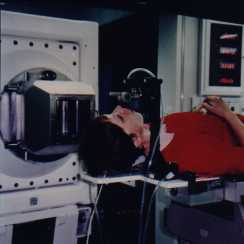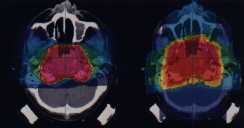

About one third of all Europeans suffer once in their lifetime from some form of cancer, and only 45% are cured by various therapies. Every 1% gained on this value corresponds to about ten thousand lives; thus every small gain of this factor is fully justified.
Radiotherapy with x- and g-rays is already a very effective tool in this battle against tumours, either alone or in combination with surgery and/or chemotherapy. New methods allow the delivery of higher doses to the target with a better sparing of the surrounding healthy tissues.
“Hadrontherapy” uses beams of charged particles and allows the cure of tumours located near critical organs.
The name Hadrontherapy combines a term used in fundamental physics (hadrons are the particles made of quarks) and a medical term (therapy) which carries a message of hope.
1) Left: computer tomography image of a human head. The target area inside the red line is very close to the brain stem, indicated by the green contour. The colour areas correspond to more than 90% (red) and less than 10 % (blue) of the nominal dose. In the lateral direction, the dose drops within a few millimeters.
Right: reconstructed distribution of positron activity with maximum (red) inside the target volume (the incident beam yields radioactive carbon nuclei which decay emitting positrons, used here as in the PET).
2) Setup for an irradiation at the Loma Linda University Medical Center horizontal beam line. The patient is immobilized by a system, which allows repositioning with an error of less than 1mm.